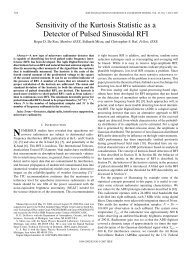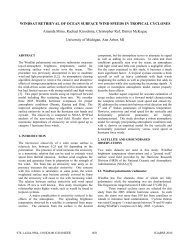Jason Microwave Radiometer performance and on-orbit - Remote ...
Jason Microwave Radiometer performance and on-orbit - Remote ...
Jason Microwave Radiometer performance and on-orbit - Remote ...
You also want an ePaper? Increase the reach of your titles
YUMPU automatically turns print PDFs into web optimized ePapers that Google loves.
<str<strong>on</strong>g>Jas<strong>on</strong></str<strong>on</strong>g> <str<strong>on</strong>g>Radiometer</str<strong>on</strong>g> Performance <str<strong>on</strong>g>and</str<strong>on</strong>g> Calibrati<strong>on</strong> 215are used in the APC algorithm (Equati<strong>on</strong> 3) are determined differently for each instrument.The JMR T E value is determined using a quadratic functi<strong>on</strong> of the antenna temperatures,<str<strong>on</strong>g>and</str<strong>on</strong>g> the TMR T E value is determined from a look-up table based <strong>on</strong> frequency<str<strong>on</strong>g>and</str<strong>on</strong>g> latitude. Some of the remaining RMS difference between the PDs can be explainedby the difference in the T E values. Together these sources of error should explain the remaining0.29 cm of RMS difference that is not explained by the stochastic noise of thereceivers.The JMR in-flight calibrati<strong>on</strong> has produced collocated JMR <str<strong>on</strong>g>and</str<strong>on</strong>g> TMR PD measurementsthat have no significant bias or scale error. The RMS difference between the PDmeasurements is largely explained by the stochastic noise of each receiver. Other sources oferror, such as the difference in the <strong>on</strong>-Earth sidelobe brightness <str<strong>on</strong>g>and</str<strong>on</strong>g> the spatial decorrelati<strong>on</strong>between the measurements, have minor c<strong>on</strong>tributi<strong>on</strong>s to the RMS difference. As a whole,the sources of error discussed in this secti<strong>on</strong> should explain the 0.49 cm RMS differencebetween the JMR <str<strong>on</strong>g>and</str<strong>on</strong>g> TMR PD measurements over cycles 3–21.JMR/RaOb Error AnalysisThe uncertainty of the JMR PD retrieval can also be estimated by comparis<strong>on</strong> to coincidentRaOb PDs. The RMS difference between JMR <str<strong>on</strong>g>and</str<strong>on</strong>g> RaOb PDs is a functi<strong>on</strong> of the error inthe RaOb PD measurements, the spatial <str<strong>on</strong>g>and</str<strong>on</strong>g> temporal decorrelati<strong>on</strong> between the two points,<str<strong>on</strong>g>and</str<strong>on</strong>g> the error in the JMR PD retrieval, as described byRMS JMR−RaObPD (dist, time)√= RaOb 2 + JMR 2 + Spatial(dist) 2 + Temporal(time) 2 . (11)The spatial <str<strong>on</strong>g>and</str<strong>on</strong>g> temporal decorrelati<strong>on</strong> terms in Equati<strong>on</strong> 11 can be estimated using statisticsfrom satellite or ground measurements, but the uncertainty in that estimate is unsatisfactoryfor our purposes. For example, a 5% uncertainty in the spatial decorrelati<strong>on</strong> term willcause a 17% uncertainty in the estimate of the JMR PD error. Figure 5 shows a plot of thecumulative spatial decorrelati<strong>on</strong> (RMS PD (dist)) of path delay as a functi<strong>on</strong> of separati<strong>on</strong>distance. This was estimated by forming a data set of path delay differences as a functi<strong>on</strong>of separati<strong>on</strong> from N JMR PD measurements. Then the cumulative spatial decorrelati<strong>on</strong> atdist km is equal to the RMS of the PD differences with spatial separati<strong>on</strong>s from 0 km todist km, shown in Equati<strong>on</strong> 12.Spatial(dist) ∼ = RMS PD (dist)[] 1i=N1 ∑ r=dist21 ∑=[PD i (r 0 ) − PD j (r 0 + r)] 2 . (12)N max( j)i=1r=0A least-squares regressi<strong>on</strong> of the cumulative spatial decorrelati<strong>on</strong> (Equati<strong>on</strong> 12) was fit tothe data. An exp<strong>on</strong>ential functi<strong>on</strong> of the form(RMS PD (dist) = c RMS0 − c RMS1 exp − dist )(13)c RMS2is used, which is reas<strong>on</strong>able because the spatial decorrelati<strong>on</strong> should asymptotically approacha c<strong>on</strong>stant value at large spatial separati<strong>on</strong>s. The least-squares best fit of the spatial





